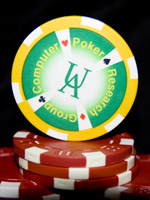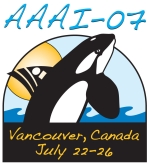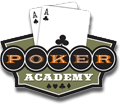The First Man-Machine
Poker Championship
Details
Who: Poker professionals Phil Laak and Ali Eslami will play against the computer poker champion, Polaris.
What: The First Man-Machine Poker Championship.
Where: The Hyatt Regency Hotel, Vancouver, Canada, during the conference of the Association for the Advancement of Artificial Intelligence (AAAI).
When:
- Session 1: Monday, July 23, 2007. Noon. In room Regency F
- Session 2: Monday, July 23, 2007. 6:00pm. In room Regency F
- Session 3: Tuesday July 24, 2007. Noon. In room Plaza B
- Session 4: Tuesday July 24, 2007. 6:00pm. In room Plaza B
Why: To test the strength of the latest poker AI against elite human professional players.
The general goal of this AI research is to learn how to handle computational problems involving uncertainty and imperfect information. One specific goal is to eventually produce a poker program that is stronger than all human players. To accomplish that, we need to assess our programs against very strong human players, with real money on the line.
Rules
- The game for the event will be two-player Limit Texas Hold'em.
- A team of two humans will play against a team of two computer programs (both being copies of the Polaris poker technology).
- Teammates will play the same series of hands, but from opposite sides (one North, the other South) to reduce the element of luck to a minimum.
- No communication between teammates is permitted during play.
- All players (bot and human) will connect to an independent poker server run by Poker Academy (www.poker-academy.com), which will administer the parallel games.
- Each series of cards will be generated randomly, based on a combination of independent seeds provided by the human team, representatives of the bot team, the match arbiter, and the match administrators (no single entity determines the cards to be dealt).
- There will be four duplicate sessions of 500 hands each, played over two days (two sessions per day).
- The human team will receive an additional $5,000 for each session that is won by more than +25 small bets (+0.05 sb/h).
- The human team will receive an additional $2,500 for each session that is won or lost by +25 small bets or less (a statistical tie).
- All hands played will be made publicly available after the completion of the event.
Duplicate matches
In poker, luck has an enormous impact on short-term results. Even playing many thousands of games can be inconclusive in deciding the best player. In typical contests with only a few hundred hands and rapidly increasing blinds and antes, the outcome is largely a coin-flip -- Lady Luck almost always decides the issue.
The Man versus Machine match is a scientific experiment, and has been designed to gain as much statistical evidence as possible, measuring the difference in skill while factoring out much of the luck element inherent in the game of poker. To this end, each 500-hand session will be played as a duplicate match.
This means that the same series of cards will be used in the two parallel matches, with the two humans having the opposite hands in each match. In other words, Ali will have the "North" seat against Polaris_A, whereas Phil will have the "South" seat against Polaris_B. No communication is allowed between the two humans, nor between the separate copies of the Polaris program.
At the end of each session, the combined bankroll of the human team will be compared to the combined bankroll of the bot team to determine the winner of the duplicate match. In the case of a small margin of victory (within 25 small bets of break-even), the match will be declared a statistical tie. Four separate duplicate sessions will be played over the two-day series, allowing both teams an opportunity to learn more about their opponent, and adjust their strategy accordingly.
Duplicate matches have been shown to greatly reduce the natural variance in poker due to luck. The format has been studied both theoretically and empirically in recent publications by the U of A Computer Poker Research Group.
[Technical references: ICGA journal article, AAAI paper, Darse's thesis, Morgan's thesis]





